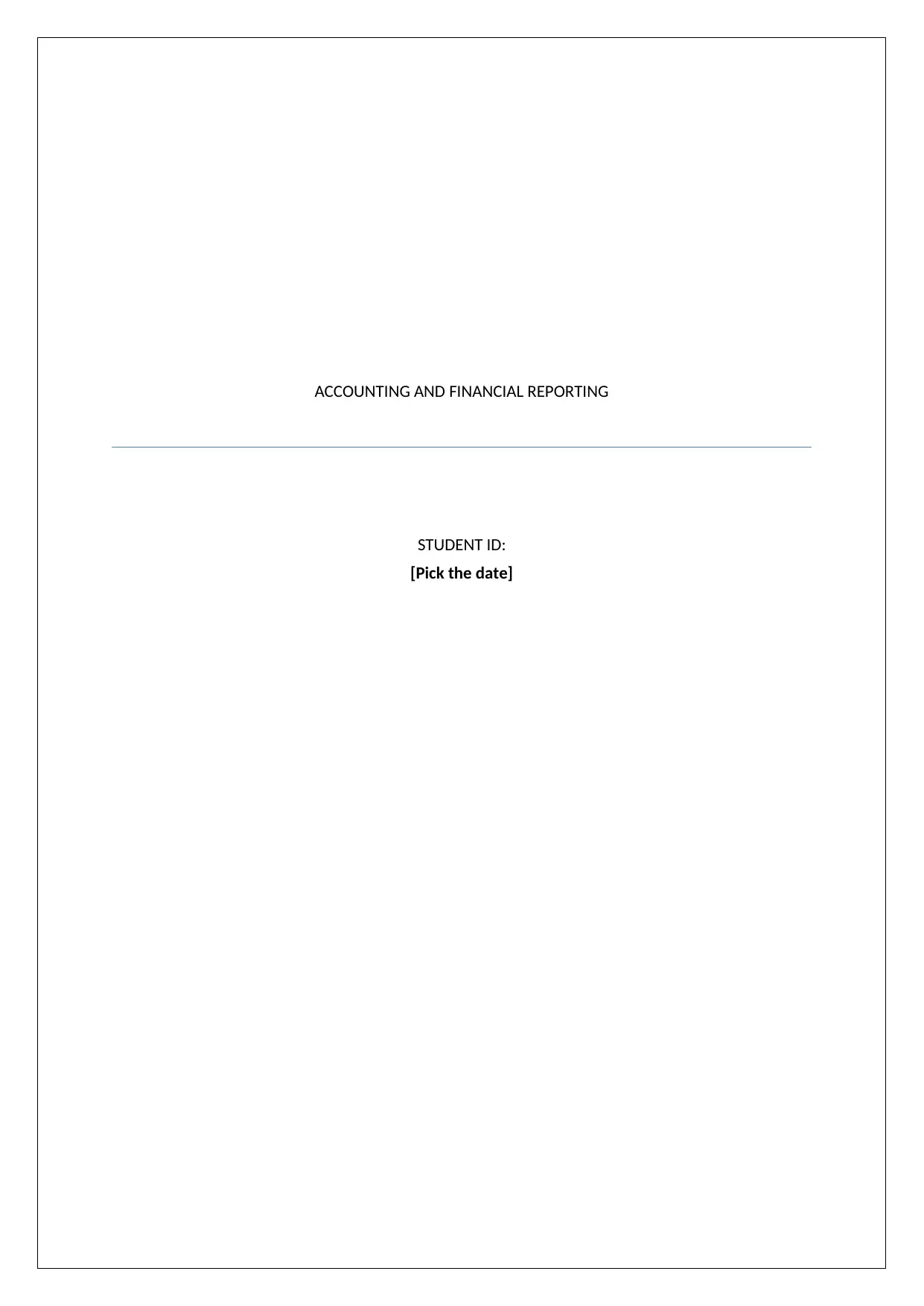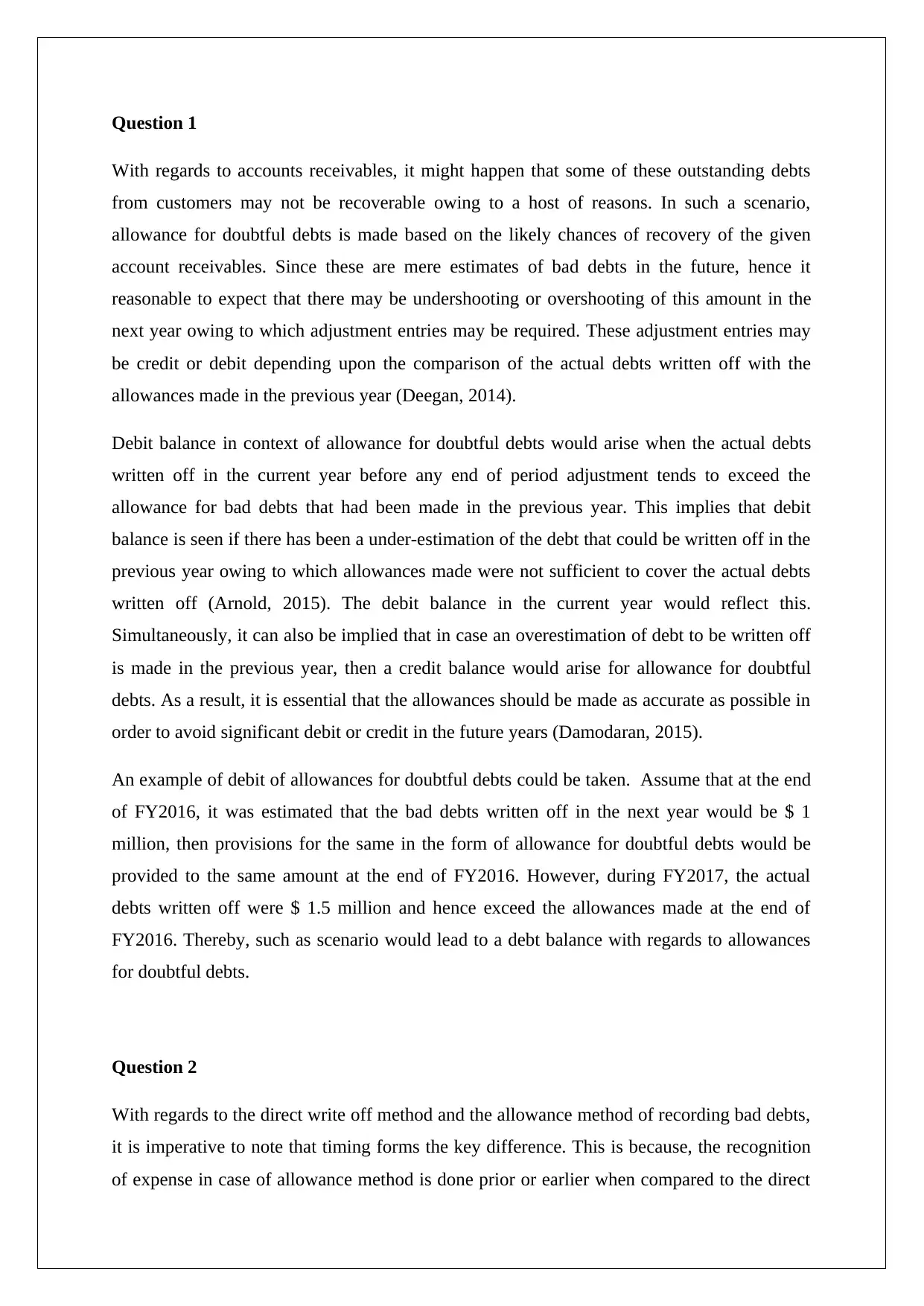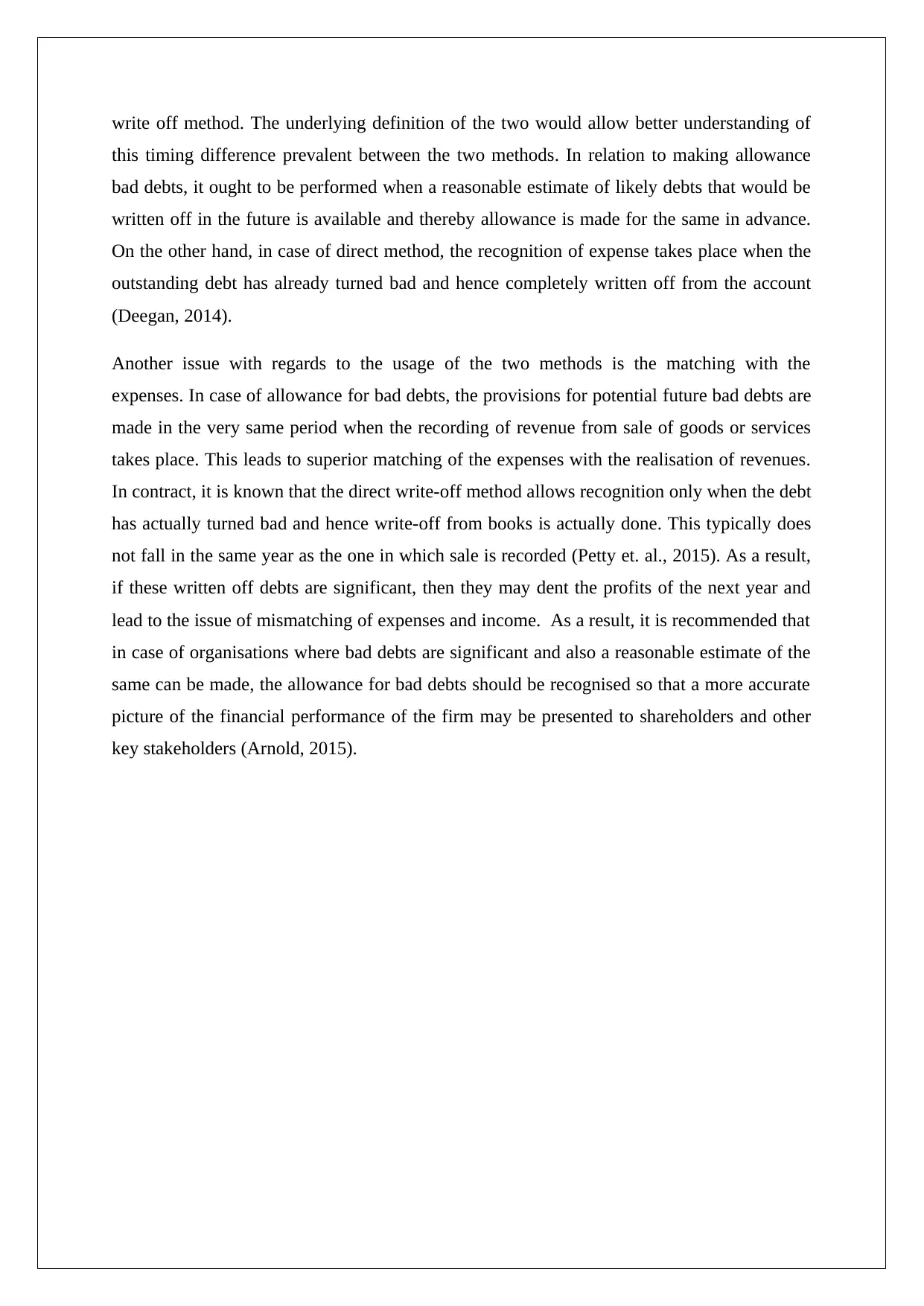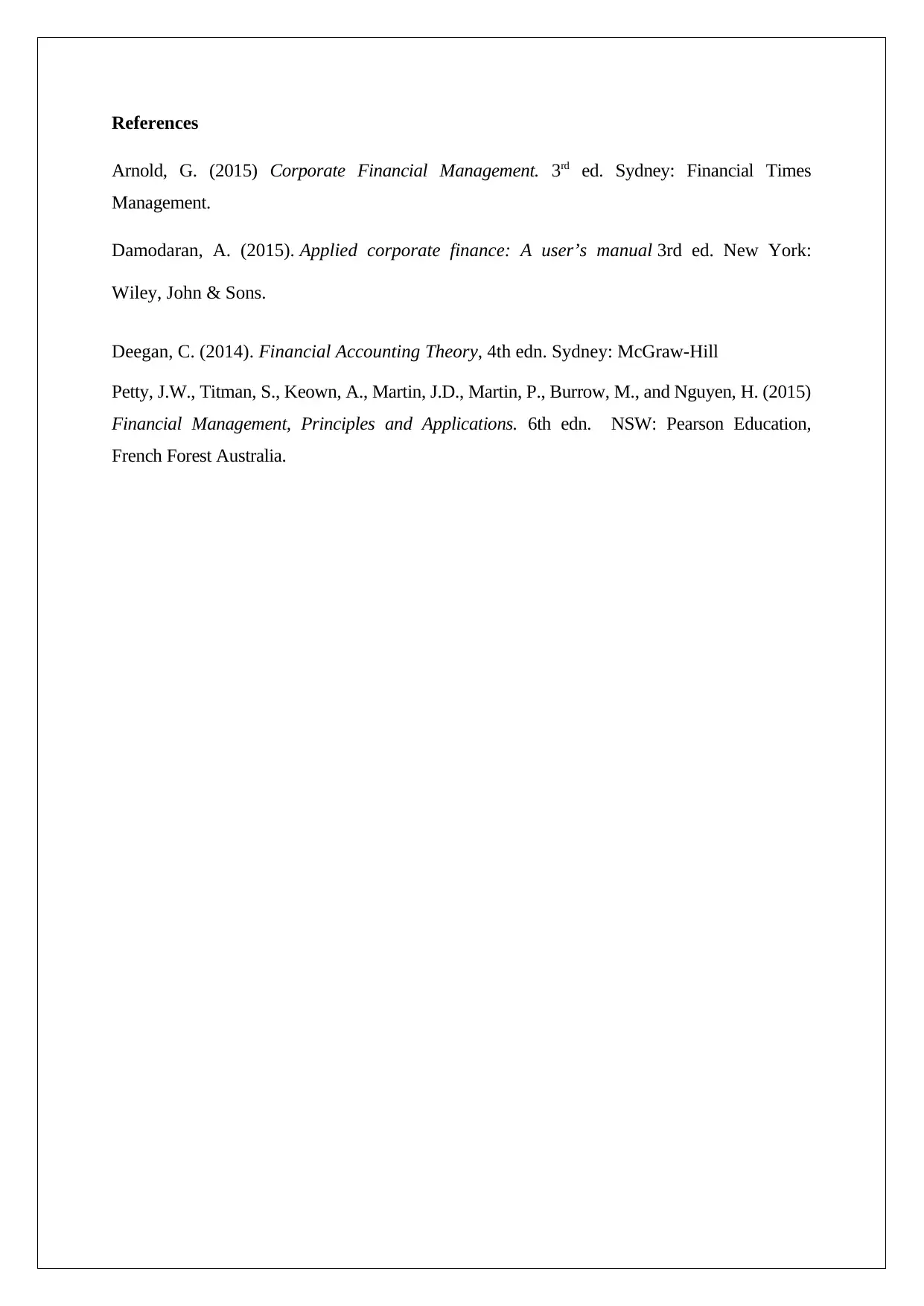Accounting and Financial Reporting: Analyzing Doubtful Debts Methods
VerifiedAdded on 2023/06/06
|4
|919
|305
Homework Assignment
AI Summary
This assignment solution delves into accounting for doubtful debts, addressing the allowance for doubtful debts and the potential for debit or credit balances due to estimation inaccuracies. It explains how debit balances arise from underestimation of bad debts and credit balances from overestimation. The solution also differentiates between the direct write-off method and the allowance method, highlighting timing and expense matching differences. The allowance method is recommended for organizations with significant bad debts that can be reasonably estimated, ensuring a more accurate financial representation. Desklib offers a wealth of similar resources for students.

ACCOUNTING AND FINANCIAL REPORTING
STUDENT ID:
[Pick the date]
STUDENT ID:
[Pick the date]
Paraphrase This Document
Need a fresh take? Get an instant paraphrase of this document with our AI Paraphraser

Question 1
With regards to accounts receivables, it might happen that some of these outstanding debts
from customers may not be recoverable owing to a host of reasons. In such a scenario,
allowance for doubtful debts is made based on the likely chances of recovery of the given
account receivables. Since these are mere estimates of bad debts in the future, hence it
reasonable to expect that there may be undershooting or overshooting of this amount in the
next year owing to which adjustment entries may be required. These adjustment entries may
be credit or debit depending upon the comparison of the actual debts written off with the
allowances made in the previous year (Deegan, 2014).
Debit balance in context of allowance for doubtful debts would arise when the actual debts
written off in the current year before any end of period adjustment tends to exceed the
allowance for bad debts that had been made in the previous year. This implies that debit
balance is seen if there has been a under-estimation of the debt that could be written off in the
previous year owing to which allowances made were not sufficient to cover the actual debts
written off (Arnold, 2015). The debit balance in the current year would reflect this.
Simultaneously, it can also be implied that in case an overestimation of debt to be written off
is made in the previous year, then a credit balance would arise for allowance for doubtful
debts. As a result, it is essential that the allowances should be made as accurate as possible in
order to avoid significant debit or credit in the future years (Damodaran, 2015).
An example of debit of allowances for doubtful debts could be taken. Assume that at the end
of FY2016, it was estimated that the bad debts written off in the next year would be $ 1
million, then provisions for the same in the form of allowance for doubtful debts would be
provided to the same amount at the end of FY2016. However, during FY2017, the actual
debts written off were $ 1.5 million and hence exceed the allowances made at the end of
FY2016. Thereby, such as scenario would lead to a debt balance with regards to allowances
for doubtful debts.
Question 2
With regards to the direct write off method and the allowance method of recording bad debts,
it is imperative to note that timing forms the key difference. This is because, the recognition
of expense in case of allowance method is done prior or earlier when compared to the direct
With regards to accounts receivables, it might happen that some of these outstanding debts
from customers may not be recoverable owing to a host of reasons. In such a scenario,
allowance for doubtful debts is made based on the likely chances of recovery of the given
account receivables. Since these are mere estimates of bad debts in the future, hence it
reasonable to expect that there may be undershooting or overshooting of this amount in the
next year owing to which adjustment entries may be required. These adjustment entries may
be credit or debit depending upon the comparison of the actual debts written off with the
allowances made in the previous year (Deegan, 2014).
Debit balance in context of allowance for doubtful debts would arise when the actual debts
written off in the current year before any end of period adjustment tends to exceed the
allowance for bad debts that had been made in the previous year. This implies that debit
balance is seen if there has been a under-estimation of the debt that could be written off in the
previous year owing to which allowances made were not sufficient to cover the actual debts
written off (Arnold, 2015). The debit balance in the current year would reflect this.
Simultaneously, it can also be implied that in case an overestimation of debt to be written off
is made in the previous year, then a credit balance would arise for allowance for doubtful
debts. As a result, it is essential that the allowances should be made as accurate as possible in
order to avoid significant debit or credit in the future years (Damodaran, 2015).
An example of debit of allowances for doubtful debts could be taken. Assume that at the end
of FY2016, it was estimated that the bad debts written off in the next year would be $ 1
million, then provisions for the same in the form of allowance for doubtful debts would be
provided to the same amount at the end of FY2016. However, during FY2017, the actual
debts written off were $ 1.5 million and hence exceed the allowances made at the end of
FY2016. Thereby, such as scenario would lead to a debt balance with regards to allowances
for doubtful debts.
Question 2
With regards to the direct write off method and the allowance method of recording bad debts,
it is imperative to note that timing forms the key difference. This is because, the recognition
of expense in case of allowance method is done prior or earlier when compared to the direct

write off method. The underlying definition of the two would allow better understanding of
this timing difference prevalent between the two methods. In relation to making allowance
bad debts, it ought to be performed when a reasonable estimate of likely debts that would be
written off in the future is available and thereby allowance is made for the same in advance.
On the other hand, in case of direct method, the recognition of expense takes place when the
outstanding debt has already turned bad and hence completely written off from the account
(Deegan, 2014).
Another issue with regards to the usage of the two methods is the matching with the
expenses. In case of allowance for bad debts, the provisions for potential future bad debts are
made in the very same period when the recording of revenue from sale of goods or services
takes place. This leads to superior matching of the expenses with the realisation of revenues.
In contract, it is known that the direct write-off method allows recognition only when the debt
has actually turned bad and hence write-off from books is actually done. This typically does
not fall in the same year as the one in which sale is recorded (Petty et. al., 2015). As a result,
if these written off debts are significant, then they may dent the profits of the next year and
lead to the issue of mismatching of expenses and income. As a result, it is recommended that
in case of organisations where bad debts are significant and also a reasonable estimate of the
same can be made, the allowance for bad debts should be recognised so that a more accurate
picture of the financial performance of the firm may be presented to shareholders and other
key stakeholders (Arnold, 2015).
this timing difference prevalent between the two methods. In relation to making allowance
bad debts, it ought to be performed when a reasonable estimate of likely debts that would be
written off in the future is available and thereby allowance is made for the same in advance.
On the other hand, in case of direct method, the recognition of expense takes place when the
outstanding debt has already turned bad and hence completely written off from the account
(Deegan, 2014).
Another issue with regards to the usage of the two methods is the matching with the
expenses. In case of allowance for bad debts, the provisions for potential future bad debts are
made in the very same period when the recording of revenue from sale of goods or services
takes place. This leads to superior matching of the expenses with the realisation of revenues.
In contract, it is known that the direct write-off method allows recognition only when the debt
has actually turned bad and hence write-off from books is actually done. This typically does
not fall in the same year as the one in which sale is recorded (Petty et. al., 2015). As a result,
if these written off debts are significant, then they may dent the profits of the next year and
lead to the issue of mismatching of expenses and income. As a result, it is recommended that
in case of organisations where bad debts are significant and also a reasonable estimate of the
same can be made, the allowance for bad debts should be recognised so that a more accurate
picture of the financial performance of the firm may be presented to shareholders and other
key stakeholders (Arnold, 2015).
⊘ This is a preview!⊘
Do you want full access?
Subscribe today to unlock all pages.

Trusted by 1+ million students worldwide

References
Arnold, G. (2015) Corporate Financial Management. 3rd ed. Sydney: Financial Times
Management.
Damodaran, A. (2015). Applied corporate finance: A user’s manual 3rd ed. New York:
Wiley, John & Sons.
Deegan, C. (2014). Financial Accounting Theory, 4th edn. Sydney: McGraw-Hill
Petty, J.W., Titman, S., Keown, A., Martin, J.D., Martin, P., Burrow, M., and Nguyen, H. (2015)
Financial Management, Principles and Applications. 6th edn. NSW: Pearson Education,
French Forest Australia.
Arnold, G. (2015) Corporate Financial Management. 3rd ed. Sydney: Financial Times
Management.
Damodaran, A. (2015). Applied corporate finance: A user’s manual 3rd ed. New York:
Wiley, John & Sons.
Deegan, C. (2014). Financial Accounting Theory, 4th edn. Sydney: McGraw-Hill
Petty, J.W., Titman, S., Keown, A., Martin, J.D., Martin, P., Burrow, M., and Nguyen, H. (2015)
Financial Management, Principles and Applications. 6th edn. NSW: Pearson Education,
French Forest Australia.
1 out of 4
Related Documents
Your All-in-One AI-Powered Toolkit for Academic Success.
+13062052269
info@desklib.com
Available 24*7 on WhatsApp / Email
![[object Object]](/_next/static/media/star-bottom.7253800d.svg)
Unlock your academic potential
Copyright © 2020–2025 A2Z Services. All Rights Reserved. Developed and managed by ZUCOL.


